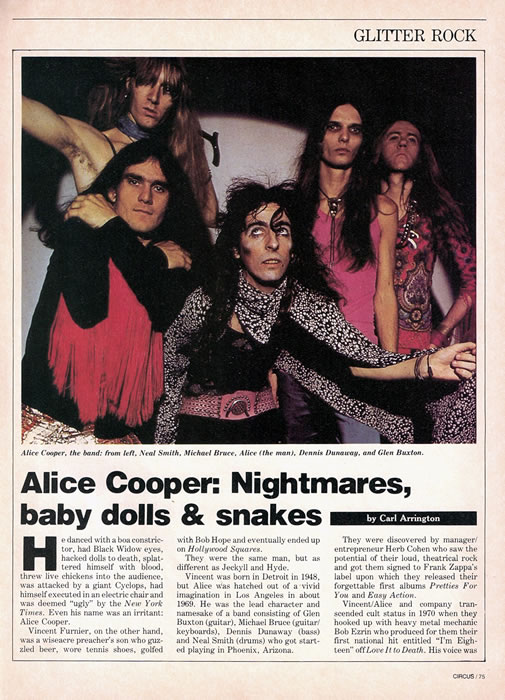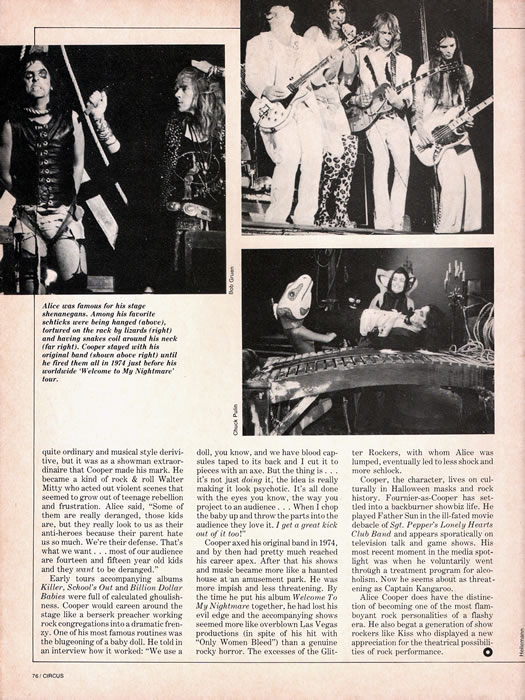Article Database
Alice Cooper: Nightmares, baby dolls & snakes
He danced with a boa constrictor, had Black Widow eyes, hacked dolls to death, splattered himself with blood, threw live chickens into the audience, was attacked by a giant Cyclops, had himself executed in an electric chair and was deemed "ugly" by the New York Times. Even his name was an irritant: Alice Cooper.
Vincent Furnier, on the other hand, was a wiseacre preacher's son who guzzled beer, wore tennis shoes, golfed with Bob Hope and eventually ended up on Hollywood Squares.
They were the same man, but as different as Jekyll and Hyde.
Vincent was born in Detroit in 1948, but Alice was hatched out of a vivid imagination in Los Angeles in about 1969. He was the lead character and namesake of a band consisting of Glen Buxton (guitar), Michael Bruce (guitar/keyboards), Dennis Dunaway (bass) and Neal Smith (drums) who got started playing in Phoenix, Arizona.
They were discovered by manager/entrepreneur Herb Cohen who saw the potential of their loud, theatrical rock and got them signed to Frank Zappa's label upon which they released their forgettable first albums Pretties For You and Easy Action.
Vincent/Alice and company transcended cult status in 1970 when they hooked up with heavy metal mechanic Bob Ezrin who produced for them their first national hit entitled "I'm Eighteen" off Love It to Death. His voice was quite ordinary and musical style derivative, but it was as a showman extraordinaire that Cooper made his mark. He became a kind of rock & roll Walter Mitty who acted out violent scenes that seemed to grow out of teenage rebellion and frustration. Alice said, "Some of them are really deranged, those kids are, but they really look to us as their anti-heroes because their parent hate us so much. We're their defense. That's what we want... most of our audience our fourteen and fifteen year old kids and they want to be deranged."
Early tours accompanying albums Killer, School's Out and Billion Dollar Babies were full of calculated ghoulishness. Cooper would careen around the stage like a berserk preacher working rock congregations into a dramatic frenzy. One of his most famous routines was the bludgeoning of a baby doll. He told in an interview how it worked: "We use a doll, you know, and we have blood capsules taped to it's back and I cut it to pieces with an axe, but the thing is... it's not just doing it, the idea is really making it look psychotic. It's all done with the eyes you know, the way you project to an audience... When I chop the baby up and throw the parts into the audience they love it. I get a great kick out of it too!"
Cooper axed his original band in 1974, and by then had pretty much reached his career apex. After that his shows and music became more like a haunted house at an amusement park. He was more impish and less threatening. By the time he put his album Welcome To My Nightmare together, he had lost his evil edge and the accompanying shows seemed more like overblown Las Vegas productions (in spite of his hit with "Only Women Bleed") than a genuine rocky horror. The excesses of the Glitter Rockers, with whom Alice was lumped, eventually led to less shock and more schlock.
Cooper, the character, lives on culturally in Halloween masks and rock history. Furnier-as-Cooper has settled into a backburner showbiz life. he played Father Sun in the ill-fated movie debacle of Sgt. Pepper's Lonely Hearts Club Band and appears sporadically on television talk and game shows. His most recent moment in the media spotlight was when he voluntarily went through a treatment program for alcoholism. Now he seems about as threatening as Captain Kangaroo.
Alice Cooper does have the distinction of becoming one of the most flamboyant rock personalities of the flashy era. He also began a generation of show rockers like Kiss who displayed a new appreciation for the theatrical possibilities of rock performance.
(Originally published in Circus Rock Immortals #1, in 1980)







